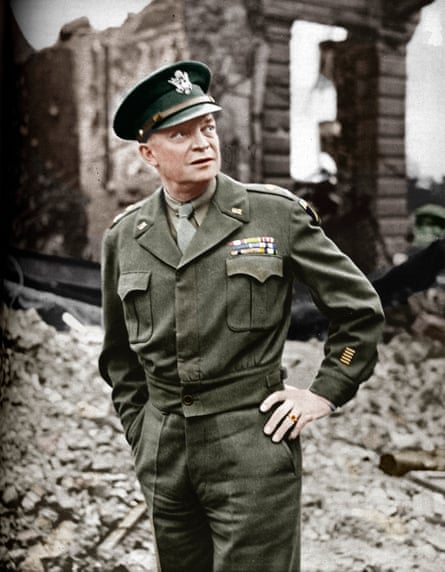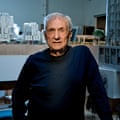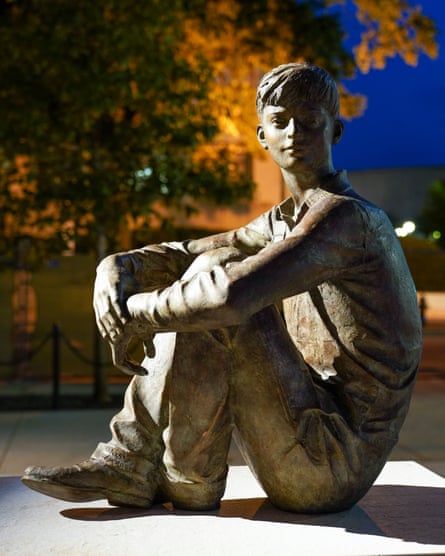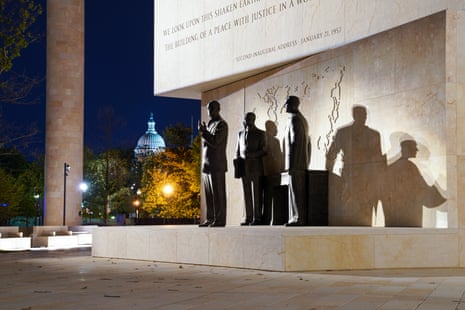It is “ugly and offensive to the eye” and “injurious to public morals”. It is “a hollow temple, not a hallowed one. The impious, soulless design evinces nothing sacred or transcendent. Base and plebeian… it mocks, in the voice of the nation, President Eisenhower and republican virtue. A de-moralised memorial, it rejects American values for an ersatz populist levelling-down. It rejects heroism and greatness.”
Thus spake Justin Shubow, president of the National Civic Art Society in Washington DC, since 2018 a Trump appointee to the US Commission for Fine Arts, and the man behind a draft executive order called “Making Federal Buildings Again” under which “the classical architectural style shall be the preferred and default style” for federal courthouses and federal buildings in the National Capital Region.

He was describing the Dwight D Eisenhower memorial in Washington, designed by Frank Gehry, which will open on 17 September, 51 years after the death of the general and president, and 21 years after Congress voted for such a thing to be built. Shubow’s words were part of a more widespread series of attacks by press and politicians over the past decade; it was called a “monstrosity”, an example of “commemorative bric-a-brac,” a “classic Washington boondoggle”. Its opponents compared it, reported Ike’s granddaughter Susan Eisenhower with apparent agreement, to billboards, missile silos, the fences around concentration camps, and the hagiographic art of communist dictators.
Throughout the process, Gehry, now aged 91, has professed his admiration for Eisenhower. When he read up on the general’s biography, as he tells me by Zoom from his home in Santa Monica, California, “I came away blindsided. It brings tears to my eyes. How his accomplishments as a general and as a president match anything, all without the fanfare that’s going on around the president now. The opposite. He was modest but strong. A staggering accomplishment.”
Gehry’s proposal was to erect three “tapestries” – large, woven stainless-steel screens that would enclose three sides of a public square. They would obscure the mediocre elevations of surrounding government buildings behind them and give shape to what Gehry says was “an impossible, irreverent site”, a parking lot dominated by busy roads. The screens were to be etched with images of Eisenhower’s home town of Abilene, Kansas. In the middle there was to be a statue of the great man as a boy.


The idea was to honour his humility. “The proudest thing that I can claim,” Eisenhower himself declared “is that I am from Abilene.” This stress on ordinariness, however, was for Eisenhower’s family and other critics one of the project’s problems: they felt that this narrative paid insufficient honour to the heroic events in which Eisenhower took part.
Other objections included the screens’ effect on a view of the Capitol. It was criticised for its scale, its footprint being larger than the Lincoln and Jefferson memorials, an argument that overlooked the fact that it is not a single monolithic building, but contains a public garden. From Shubow’s point of view its greatest crime was its refusal to follow the classical style of past presidential memorials, and never mind that one of the most successful public works in Washington, Maya Lin’s Vietnam Veterans memorial, has neither a column nor a pediment in sight.

Gehry now wants to stress that he respected at least some of these criticisms: “The Eisenhower family are very intelligent. My relationship has always been cordial, and since we got it all sorted Susan has been just wonderful. I don’t blame them – they were getting ripped from 20 directions at once, and they had never done a memorial before.” His contempt is reserved for the “arbitrary bullshit” that “it should be classical architecture, period, and there’s no room for any invention or new expression as the world continues to change”.
“It was a correct read by the family,” Gehry recognises, “that [Eisenhower] deserved accolades.” So the Abilene images went, to be replaced (at the suggestion of the former secretary of state James Baker) by an enlarged drawing of Pointe du Hoc in Normandy, scene of some of the most intense fighting in the D-day landings. The two screens that got in the way of the view of the Capitol dome were omitted, leaving one long one down one side of the site, supported on a row of hefty columns. The image on the one remaining screen is intended to be inconspicuous by day, says Gehry, “so that people working around the area are not bothered by it”. At night “a little bit of light brings it to life”.

The statue of the boy Ike remains, but is less conspicuously located. Two other sculptural tableaux, based on famous photographs of Eisenhower as general and as president, now take centre stage. The boy is life-size, the other figures about nine feet high, “which gives them a little bit of an edge”. Made by the sculptor Sergey Eylanbekov, they are straightforwardly representational, not abstract. The aim is “to tell a story”, and to be both heroic and human.
It’s possible, to judge by views down electronic tubes from a distance of 3,600 miles, that the memorial doesn’t have the compressed and restless energy of Gehry’s most memorable works, but neither does it look like the soulless monster that its opponents described. It appears to combine dignity with intimacy, and the conventions of figurative sculpture with the digital technology that makes the screen possible. It looks like a place to inhabit as well as to remember, where the weight of history can be experienced as either foreground or background, where you can choose whether to eat a sandwich or think about world war, or both.
It’s a feature of new public memorials that everyone can agree about the what, no one about the how. It must have been the easiest thing in the world for Congress to sign off an Eisenhower memorial in 1999 – who could object? – but the realisation raises multiple anxieties about the right way of representing a hero who is no longer able to take part in the discussion himself. This process of coming to terms with a historic figure is perhaps as important as the finished object. Gehry says the project is “absolutely” stronger for it. “I feel much more comfortable standing beside what we’ve done, given all the people I’ve talked to who knew him, who experienced his life.”
Covid-19 delayed the memorial’s inauguration from the 75th anniversary of Victory in Europe, in May. It will now open in the run-up to an election in which the extent of the incumbent’s “republican virtue”, to use Shubow’s words, and of his “ersatz populist levelling-down” will be no small matters. When it comes to “heroism and greatness”, the comparison with Eisenhower will hardly be favourable to Trump.
